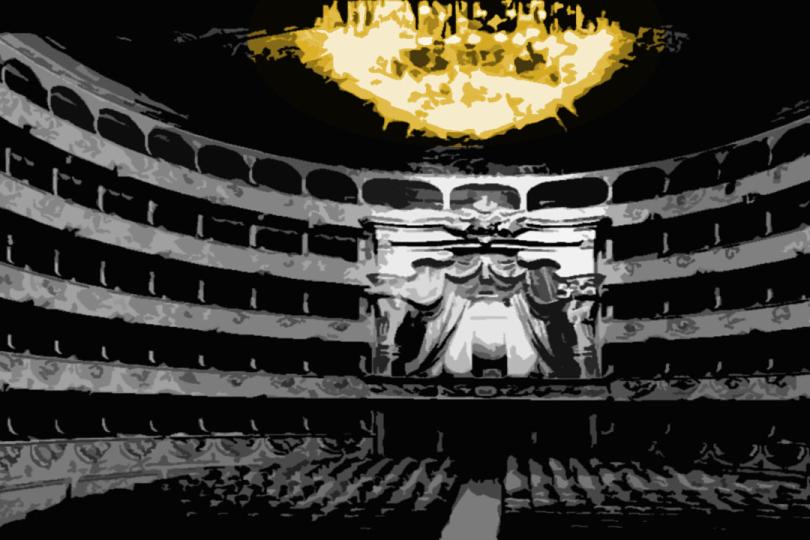A bright idea

Last year in Shows for Days, Patti Lupone snatched a mobile phone from a theatergoer as she exited stage left. The theatergoer had spent most of the show texting and Patti took the matter into her own hand. Patti said this afterward:
“When a phone goes off, or when a LED screen can be seen in the dark, it ruins the experience for everyone else: the majority of the audience at that performance and the actors on stage.”
Patti isn’t just upset about a ringing mobile phone. Because we usually turn off the houselights during shows, we exacerbate mobile phone problem; the LED light is a distraction in a dark house whether or not the phone rings.
I think a lot of us have been frustrated by mobile phones in theater, and none of us know what to do. Like Patti we aggressively attack the offending theatergoer or we passive-aggressively complain to management, but, since the FCC ruled that we cannot install cellphone jammers in theaters, we can do nothing proactive. We are at the mercy of the worst among us.
I suggest a proactive step: I argue that we should form a Claque.
I mean that we should turn up the houselights during all movies, theater, and opera to allow audience members who are intensively watching the show to exemplify that attention to one another. I think this is not only the only available response to a technology like social media and smart phones that will not disappear but it also may be a great way to come together in a world divided by demographics and data targeting.
Interruption was part of the show
For the last one hundred years, we in America have watched media a certain way. We are passive and quiet as we receive the message. If we are out at the cinema or theater, we receive Patti’s message in the dark and we quietly return home. Maybe we take a bath and meditate on the art and light candles to eroticize the experience, but that’s as interactive as the media should be for an intensive viewer. We never would speak out during a performance or yell from the pit. We do not behave as an interactive audience; rather, we behave as a group of viewers of a broadcast.
We have inherited our passive, intensive watching aesthetic from two sources. One source is film, which needs a dark house for proper viewing. The second source is Wagner.
Wagner encouraged intensive watching of his operas, and his aesthetic is a direct reaction to an older tradition of selective listening that we see in baroque and eighteenth century theater. The older, pre-Wagner theater was a two-way relationship whereas Wagner's is a one-way relationship.
The older, pre-Wagner aesthetic helps us understand the cellphone problem because the audience could listen or not listen as desired and the opera houses before Wagner’s time were lit. The auditorium had a horseshoe shape, which allowed the audience to watch itself watch the show. The chairs were movable, so the audience members could turn away from the show to talk, laugh, drink champagne, or gawk at one another. They could speak amongst themselves as well as sing along or catcall from the pit.
Wagner found all this distasteful and silly, so he made some changes: he oriented all the chairs into a semicircle and focused each one at the stage. Next, he bolted the chairs to the floor. He narrowed the isles, and he restrained the seating. Then he turned off the houselights so the audience could not see itself. The only light was the stage itself.
Wagner turned the audience towards the stage, restrained them, and turned off the houselights to help focus attention on his art. He even adopted a religious undertone or a sacramental view of his work: his music, he thought, expressed the authentic feelings which had otherwise been made unintelligible to the audience by state politics or religious dogma. It was only through an intensive viewing of his artwork that social progress occurred or authenticity revealed itself.
With Twitter, the pit is back
Today, the houselights are still dark, and we still have restrained seating, but a significant change has also crept in: social media and smart phones have added a new light to our dark theater experiences. Smart phones allow us all to behave more like the audiences of baroque and eighteenth century opera houses rather than the more recent twentieth century audience: we can watch one another watch a show. With social media, suddenly all forms of media are interactive.
Our smart phones signal the death of the current “broadcast” model of theater, and that will have important changes to how audiences behave during shows. What is the difference between a troll catcalling during a Shakespeare play years ago, and a troll #hatewatch on Twitter? With Twitter, the pit is back.
Actors like Patti feel the change and are straining their acting to capture the attention of the distracted audience. Patti herself said, “I am so defeated by this issue that I seriously question whether I want to work on stage anymore. Now I'm putting battle gear on over my costume to marshal the audience as well as perform.”
Viewers, Patti feels, are no longer listening to her broadcast, so she has to marshal the audience as well as portray the character. This is probably exhausting and, as she says, makes her feel defeated.
What can be done?
In the past, actors actually had help marshaling attention: they had a Claque. The Claque was a body of professional audience members who attended each performance of the show with the purpose of marshaling audience attention. The Claque had a conductor who signaled when to clap, cheer, hiss, laugh, or weep publically.
A Claque worked because it was aware of itself as an audience. The Claque can be the audience marshaling itself so that Patti doesn’t have to.
If we are aware of ourselves as an audience watching a show, we can model consent; we can showcase polite behavior; we can exemplify how the show has moved us, but to do any of this, we need the houselights up. Once we can see one another react to something, we are a good deal closer to creating common ground among ourselves as citizens of a nation.
We are an audience instead of a group of individuals from various demographics.
For theater to be great in an age of selective listening, the audience needs to play a stronger role. To do this, we need the houselights up so we can see one another and, each one of us, perform our best behavior for one another. We need to watch one another react to Patti’s performance and try to understand why we react as we do as well as share our own reactions. Whatever happens to theater in the coming years we do know this: social media has made theater two-way again.
Will we help Patti marshal her audience, or will we sit back in the quiet darkness and watch her attempt to be Claque and performer both?
Read a full version of this essay here. Or, to receive author updates or free books, please visit www.jaredmink.com.




